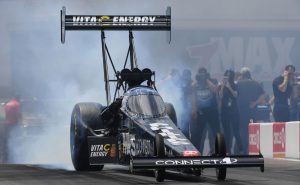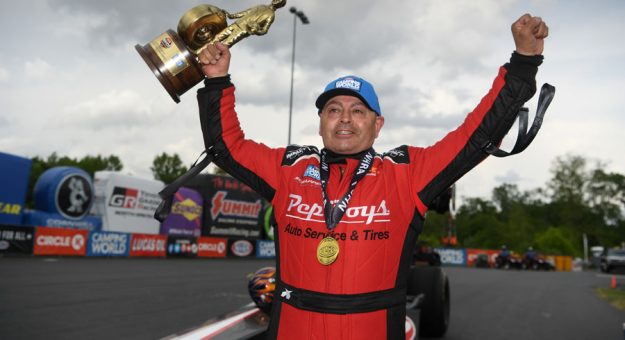Not that long ago, Tony Schumacher, Doug Kalitta and Larry Dixon were the main faces of the NHRA Top Fuel class. They were followed by Antron Brown with three championships and Steve Torrence with four straight.
The landscape is changing dramatically.
Today, Brown and Torrence, are considered role models and veterans, while the class has emerging new — though not necessarily young — faces.
What this new group of drivers brings to the table are blueprints for growing the sport with new-to-NHRA sponsors and a hand-out to the younger generation of racers. Kalitta Motorsports’ marketing expertise has set the standard, displaying a knack for adding sponsors even during the pandemic.
But Top Fuel racers Justin Ashley and Josh Hart, as well as part-time competitors Joe Morrison and Buddy Hull, have figured out how to bring new, non-automotive companies into the sport.
Ashley has built his program on maximizing business-to-business relationships. Better yet, he has managed not to let the business side of racing interfere with his on-track performance.
Coupled with his social-media savvy (he recently helped Phillips Connect raise $30,000 for Ukraine war relief, putting donors’ names on the front wing of his dragster), the 27-year-old Long Island real-estate developer has become respected by his peers for his off-track execution, too.
Because he has taken time to immerse himself in the corporate culture of his business associates, Ashley turned a three-race trial into a full-season program with Phillips Connect, a transportation-industry difference-maker.
Rob Phillips, founder and CEO of Phillips Connect, said, “We immediately saw he was in sync with our company culture and objectives. He came in early and spent a week in California learning about our products, sitting in on customer Zoom meetings and performing product installations. He was sincerely interested in learning why our products and company existed, and the extensive value that our products bring to the transportation industry. Justin knew that by creating a deeper understanding, he’d be much more valuable as a brand ambassador for Phillips Connect.”

Ashley said, “I loved spending time with Phillips Connect at their headquarters. It was a great opportunity to immerse myself in the company, their products and the culture they’ve instilled within the organization. I believe it’s important to know about the products and people you’re representing. This gave me real insight into everything they do and the reasons why they do them.”
Jim Epler, former Funny Car driver and executive vice-president of Phillips Connect, recognized the link between his business and Ashley’s.
“With the success we’ve had in the first three races, we’d be crazy not to continue sponsoring Justin’s team,” Epler said. “He is as good at being our brand ambassador and hosting customers as he is at driving 330 mph on the track. We’ve found that by creating an environment where we really get to know our customers and their needs, while providing them with a behind-the-scenes view of a world-class racing team, we could exceed our sales goals.
“After just three races, we’ve seen significant sales opportunities with key customers come to life, thanks to our association with Justin and the NHRA.”
Hart, who is still hailed for winning the 2021 Gatornationals in his first professional race, has discovered that same rapport with R+L Carriers.
For Hart, the marketing relationship goes beyond the act of using his Top Fuel dragster as a rolling billboard.
The 38-year-old is an active recruiter for the trucking firm, participating in meet-and-greets at every stop on the tour and exposing fans to the career opportunities R+L Carriers has to offer.
The owners of R+L Carriers also own the grand, state-of-the-art World Equestrian Center at Ocala. Hart had his race car on display there last year during the facility’s Grand Prix horse show to announce their partnership.
Their relationship has blossomed and Hart spearheaded a high-end auto auction that involved cars and trucks built and restored by Hart’s own Burnyzz Speed Shop and grossed more than $1 million.
With tips from Kalitta Motorsports’ Bob Lawson and retired sportsman ace Megan Meyer Lingner, Morrison devised his plan. Morrison said, “I’m introducing my existing partners to other partners. I’m looking to bring in partners that are good fits strategically for the other partners we already have on board. I’m trying to go about it so we can deliver results. Then, I’m trying to build a portfolio of businesses that will all benefit not only from working with my team but will benefit from working with each other. There’s my magic sauce, if you want to call it that.”
Hull has had his hands full with purchasing his own team and getting traction with that, but he is a former vice-president of L.A. Fitness, the nationwide network of gyms.
“At heart, I’m a businessperson. I’m an entrepreneur. I’m a partner in four other companies. I own a construction company solely. I’m always thinking about business. This is a business. This is a huge-money business,” he said of drag racing. “So if you’re not managing it the right way and you’re not thinking about it the right way, it’s not going to work.”
With even the larger NHRA teams playing “small ball” — gathering a group of sponsors instead of asking one company for $ 4 million — Hull has an approach he believes will resonate with potential partners. What plays in Pomona might not be popular in Indianapolis or Dallas.
“The fans are different at every track you go to,” he said. Therefore, the demographics and psychographics are different for his marketing program.
His method is different than the sanctioning body’s. He said it is “trying to do the same thing everywhere we go. We expect people to act our way. No — we’ve got to act their way.”
Camrie Caruso, who at age 24 and with fewer than 10 races on her Pro Stock résumé, concluded a long time ago that “the days of people giving away money are over. You have to find out how you can benefit them, or they don’t care how they can benefit you. So I try to find business-to-business things that work for them, maybe a customer for them. I could always have an agency, but I feel like it’s better to do it yourself, because then it’s personal. It’s special that way. I want to work for it, because it means more.”
Gatornationals runner-up Doug Foley is taking that direction. He said, “We’re proving that we can provide value to sponsors, whether it’s B2B partnerships or on-track success. It doesn’t cost as much to get involved as people might think.”
Helping ensure the sport lives on is a priority for Camping World Drag Racing Series Top Fuel regular Mike Salinas, 59, and Morrison, 52.
Morrison teamed with Island Dragway, near his home at Farmington, N.J., to host a clinic and licensing program for teens to transition from the Jr. Dragster program. The event introduced them to the NHRA’s Jr. Street program, which gives 13-16-year-old boys and girls the chance to race against their peers in full-body street vehicles with an adult co-driver.
It provides aspiring racers with a cost-effective entry point into drag racing.
Salinas, a self-made San Jose, Calif., businessman, is personally sponsoring 10-15 Jr. Dragster drivers across the country, including sisters from Nebraska and two other sisters from Pennsylvania.
“These are kids that deserve the right,” he said. At least four of them have met Salinas at the race track, where he encouraged them to try drag racing. They in turn told their parents: “Mike says, I can do it, so I want to do it.”
Salinas said, “These kids, see how they do and there’s a good possibility they’ll get a first chance (in the pro ranks) with us. The worst thing you can do to a person that’s hungry and trying to go somewhere is to put a brick wall in front of them. You got to give kids an opportunity.”
Part of doing that, Salinas said, is addressing cultural and generational differences.
“Just look around. There’s a big disconnect. Look at the age group. There are no young kids here; there are very few,” he said. “To sustain a culture, any culture, what does it take? That will tell you how many more years and this will be gone. There are different cultures. It’s different. So, knowing that, wouldn’t you want to try harder?”
The Top Fuel field — from 26-year-old Austin Prock to 51-year-old Gatornationals winner Tripp Tatum — has fresh faces. It’s no longer all about elapsed times, killer reaction times and scorching speeds.
It’s about growth and sustainability and B2B is the name of the game.
